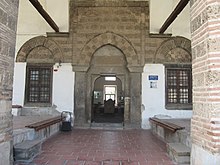Nilüfer Hatun Imareti (Turkish for "Nilüfer Hatun's Soup Kitchen"), a convent annex hospice for dervishes, now housing the Iznik Museum in İznik, Bursa Province, Turkey.[1][2] This elegant building was erected in 1388 for Murad I who dedicated it to his later mother Nilüfer Hatun.[1][2]

During Murad's reign Nilüfer s recognized as Valide Hatun, the first in Ottoman history to hold this title, and when she died she was buried beside her consort Orhan Gazi in Bursa.[1]

Architecture
editThe Imaret is built in single courses of stone alternating with four courses of bricks, its vaults and domes covered with ceramic tiles.[1] The building is preceded by an open ended porch of five bays, with five arches in front and two on either side, carried by a succession of alternating piers and columns.[1] The central bay is surmounted by a small dome, while the four side bays are covered with flat topped cross vaults. Inside, the main hall is a square surmounted by a lofty dome carried on the belt of Turkish triangles.[1] On either side there are two large rooms with much lover domes; these have large ocaklar, or hearths, and were used as both kitchens and dormitories.[1] In front of the main hall is another hall of similar size divided into two sections by a great arch; this served as a mescit, as evidenced by the mihrab niche in the south wall.[1]
Uses and restoration
editThe building originally served as a hostel for the Ahi Brotherhood of Virtue.[1] This was a religious and fraternal society formed by the craft guilds in Anatolia during the Seljuk period.[1] Ibn Battuta also wrote about the hospitality her received at one of the Ahi lodges in Anatolia.[1]
Nilüfer's foundations was later used as an imaret, or refectory, serving free food to the poor of Iznik.[1][2] The building was abandoned for many years but was restored in 1955.[3] Today it houses the Iznik Museum, with archaeological and ethnological collections, including an exhibition of the famous Iznik kilns.[1][2]
See also
editReferences
edit- ^ a b c d e f g h i j k l m John Freely (2011). A History of Ottoman Architecture. WIT Press. pp. 58–59. ISBN 978-1-845-64506-9.
- ^ a b c d Lynn A. Levine (1 Aug 2012). Frommer's Turkey. John Wiley & Sons. p. 186. ISBN 978-1-118-33364-8.
- ^ Nilüfer Hatun Soup Kitchen, ArchNet, archived from the original on 15 December 2013, retrieved 13 September 2014.